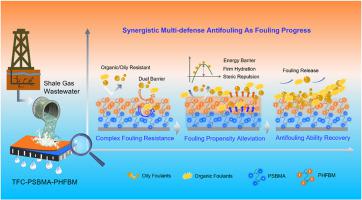当前位置:
X-MOL 学术
›
J. Membr. Sci.
›
论文详情
Our official English website, www.x-mol.net, welcomes your feedback! (Note: you will need to create a separate account there.)
Controlled architecture of multi-defense anti-fouling forward osmosis membrane for efficient shale gas wastewater treatment
Journal of Membrane Science ( IF 9.5 ) Pub Date : 2024-03-12 , DOI: 10.1016/j.memsci.2024.122625 Caihong Liu , Rui Gao , Xiaoyue Zhang , Tiezheng Tong , Qiang He , Jun Ma
Journal of Membrane Science ( IF 9.5 ) Pub Date : 2024-03-12 , DOI: 10.1016/j.memsci.2024.122625 Caihong Liu , Rui Gao , Xiaoyue Zhang , Tiezheng Tong , Qiang He , Jun Ma

|
Forward osmosis (FO) membrane process facilitates effective treatment of shale gas wastewater (SGW) due to its tolerance to high salinity and exceptional separation performance. However, serious membrane fouling remains a challenge regarding the complexity of realistic SGW. To address the fouling issues, controlled block copolymer architecture was constructed on the FO membrane surface to achieve combined effect of oil-resistance, self-regenerating, and fouling mitigation. In the modification process, zwitterionic polymer with strong hydrophilicity and fluoropolymers with low surface energy were successively grafted to the membrane active layer by atom transfer radical polymerization. The outermost fluoropolymer layer with low surface energy imparts the membrane with anti-oil and self-regenerating capabilities. Meanwhile, the strong hydration effect of the zwitterionic polymer ensures that nonspecific foulants breaking through the outermost defense are kept away from the membrane surface. According to the Extended Derjaguin-Landau-Verwey-Overbeek (XDLVO) theory, the modified FO membrane exhibited a significantly higher total interaction energy () compared to the pristine membrane when exposed to various types of model foulants (bovine serum albumin, humic acid, sodium alginate, mineral oil). Furthermore, the advantage of having multiple defense mechanisms was further substantiated through dynamic filtration tests with realistic SGW. In comparison to the pristine TFC membrane, the modified membrane not only experienced a much smaller decrease in water flux (reduced by 52%) during fouling but also an exceptional flux recovery after cleaning (∼97%). These findings underscore that the modified FO membranes greatly mitigated membrane fouling associated with SGW through the synergistic interplay between a zwitterionic polymer and a low surface energy material, highlighting its promising potential in SGW treatment via membrane technology.
中文翻译:

高效处理页岩气废水的多重防御防污正渗透膜的受控结构
正向渗透(FO)膜工艺由于其耐高盐度和卓越的分离性能,有助于有效处理页岩气废水(SGW)。然而,考虑到现实 SGW 的复杂性,严重的膜污染仍然是一个挑战。为了解决污染问题,在FO膜表面构建受控嵌段共聚物结构,以达到耐油、自再生和减轻污染的综合效果。改性过程中,通过原子转移自由基聚合将强亲水性的两性离子聚合物和低表面能的含氟聚合物先后接枝到膜活性层上。最外层的低表面能含氟聚合物层赋予膜抗油和自我再生的能力。同时,两性离子聚合物的强大水合作用确保突破最外层防御的非特异性污染物远离膜表面。根据扩展的 Derjaguin-Landau-Verwey-Overbeek (XDLVO) 理论,当暴露于各种类型的模型污染物(牛血清白蛋白、腐殖酸、海藻酸钠、矿物油)。此外,通过真实 SGW 的动态过滤测试进一步证实了多重防御机制的优势。与原始 TFC 膜相比,改性膜不仅在结垢期间水通量下降幅度小得多(降低了 52%),而且在清洗后通量恢复也非常出色(~97%)。这些发现强调,改性 FO 膜通过两性离子聚合物和低表面能材料之间的协同相互作用,极大地减轻了与 SGW 相关的膜污染,凸显了其通过膜技术在 SGW 处理中的巨大潜力。
更新日期:2024-03-12
中文翻译:

高效处理页岩气废水的多重防御防污正渗透膜的受控结构
正向渗透(FO)膜工艺由于其耐高盐度和卓越的分离性能,有助于有效处理页岩气废水(SGW)。然而,考虑到现实 SGW 的复杂性,严重的膜污染仍然是一个挑战。为了解决污染问题,在FO膜表面构建受控嵌段共聚物结构,以达到耐油、自再生和减轻污染的综合效果。改性过程中,通过原子转移自由基聚合将强亲水性的两性离子聚合物和低表面能的含氟聚合物先后接枝到膜活性层上。最外层的低表面能含氟聚合物层赋予膜抗油和自我再生的能力。同时,两性离子聚合物的强大水合作用确保突破最外层防御的非特异性污染物远离膜表面。根据扩展的 Derjaguin-Landau-Verwey-Overbeek (XDLVO) 理论,当暴露于各种类型的模型污染物(牛血清白蛋白、腐殖酸、海藻酸钠、矿物油)。此外,通过真实 SGW 的动态过滤测试进一步证实了多重防御机制的优势。与原始 TFC 膜相比,改性膜不仅在结垢期间水通量下降幅度小得多(降低了 52%),而且在清洗后通量恢复也非常出色(~97%)。这些发现强调,改性 FO 膜通过两性离子聚合物和低表面能材料之间的协同相互作用,极大地减轻了与 SGW 相关的膜污染,凸显了其通过膜技术在 SGW 处理中的巨大潜力。



























 京公网安备 11010802027423号
京公网安备 11010802027423号